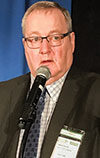When I go from my home in Minnesota to Ames, Iowa, for business meetings, Interstate 35 is a good road to take. When I go to the Black Hills of South Dakota for vacation, however, taking I-35 would be a terrible choice. Driving all day on I-35 would leave me farther away from the Black Hills than when I started.
Whether a road is a good one to take depends on where you want to go. The same goes for dairy farm policy. Before we start talking about which policy road we want to travel, we need to first ask, “Where do we want to go?” In other words, “What kind of future do we want for dairy farming?”
Here’s my answer to that question: I want to see a dairy economy in which more of the milk produced in the U.S. comes from smaller farms. Smaller dairy farms have special advantages for rural economies, the environment and our food security.
Not all policy roads get us closer to the future I would like to see. Take, for example, herd buyout programs. The ones I have seen resulted in smaller dairy farms selling out so the milk supply would go down. Before long, much larger farms took their places and quickly brought the milk supply back to excessive levels.
Why did this happen? Supply management programs of all types usually take a “rising tide floats all boats” approach, that is, a higher price benefits all farmers equally. Trouble is, not all farms are the same. Smaller dairies usually have higher costs for both production and trucking. The same price boost that barely gets these farms back to breakeven gives very large farms excessive profits. Those profits can attract more investment and/or be used to low-bid smaller farms for critical markets.
This explains why we have to be careful when we talk about “too much production.” All farms don’t contribute equally to overproduction. More likely, we see that only the largest farms are responsible for the lion’s share of growth in production. Production from smaller farms may decline even in times of overall production increases.
Because of this, I would like to stop talking about supply management in general and start talking about managing the supply of milk from larger farms. Why? Simple arithmetic. There is only so much milk that can be sold into any market. The more of that market controlled by very large farms, the less that can be sold by smaller farms.
I’ve heard agricultural economists and policy experts refer to the “structure” of dairy farming in the U.S. Being a former farmer myself, it took me a while to understand that they are not using the word “structure” in the way farmers do, that is, barns and equipment sheds. Instead, they mean how many farms produce our milk and how many cows each of those farms has.
What we have, and what I would like to see addressed, is a structure problem. We have too much of our milk coming from very large farms and not enough coming from smaller farms. That’s why we at National Farmers call our policy program a structure management program instead of a supply management program.
Our structure management plan is unique in that it specifically addresses our central policy goal: More of the milk produced in the U.S. will come from smaller dairy farms. When our policy is in place, smaller farms will get a higher price than that received by very large farms. At last, the playing field for farms of all size will be level.
We are pursuing the enactment of our Dairy Farm Structure Management Program in two steps. First, we want to establish a national Federal Milk Marketing Order that covers all milk produced in the lower 48 states. Second, we want to use the order to pay premiums on the first million pounds per month produced by each farm in the U.S.
I invite you to do two things. First, think about your dream for the future of dairy farming. Is it a structure filled with smaller farms or one even more dominated by a relative handful of enormous investor-owned operations? Second, take a look at our Dairy Farm Structure Management Plan. If you like what you see, help us get it in place while there are still smaller dairies left to save.




